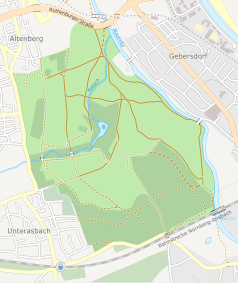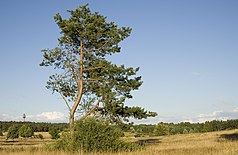Hainberg nature reserve
| Hainberg nature reserve | ||
|---|---|---|
|
|
||
| Location: | Bavaria , Germany | |
| Specialty: | Sand biotope | |
| Next city: | Oberasbach | |
| Surface: | 213 ha | |
| Founding: | 1995 | |
| Visitors: | publicly accessible ( route required ) | |
| Location map | ||
| View of the nature reserve | ||
The Hainberg nature reserve is located on the Rednitz in the area of the cities of Oberasbach and Stein ( Fürth district ) and a small part of the city of Nuremberg . The nature conservation project sand axis francs belonging Nature Reserve was established in March 1, 1995 and is about 213 hectares. On its surface was previously a training area of the US Army and stationed in Nuremberg Transportation Battalion 270 of the Bundeswehr . 195 ha of the area are therefore as natural heritage area in the administration of the DBU natural heritage .
description
The area includes the largest sandy grassland area in Northern Bavaria. Typical of this type of landscape are the low storage capacity of water, the low nutrient content of the soil and the extreme temperature differences compared to other biotopes in Central Europe. The loose vegetation, often interrupted by sandy areas, consists of grasses and low-growing herbs. What is special about the Hainberg's vegetation is the light, brownish color of the lawns.
Flora and fauna
The nature reserve is a habitat and retreat for many threatened plants and animals.
Among other things, the sand carnation , the heather carnation , the sand thyme , the silver grass , the mountain sand bell and the early Schmielenhafer occur. A special feature is the occurrence of the Austrian mugwort , which is said to have been planted as a wine spice by Croatian soldiers during the Thirty Years' War ; In 1632 the Hainberg was part of the Wallenstein camp near Zirndorf .
The insect fauna of the Hainberg includes sand bees , the blue-winged wasteland insect and the swallowtail . Among the amphibians, the natterjack toad and the garlic toad should be mentioned. The oriole , the wheatear , the red-backed killer , the blackcap , the kingfisher , the common pipit and the woodlark are rare bird species in the area .
maintenance
It is important that dry sand grass does not become overgrown, as the short, gappy grass z. B. is a prerequisite for ground-breeding birds in order to recognize enemies more quickly. This is why the lawn is kept short by cutting back the robinia stick rash by volunteers and sheep grazing. This also ensures the continued existence of the plant and insect species typical of this biotope .
In the nature reserve there is a strict leash requirement for dogs and in the core zone there are trails .
photos
Web links
Individual evidence
- ↑ a b c Ordinance on the "Hainberg" nature reserve in the Fürth district and the city of Nuremberg from January 31, 1995. (PDF; 56 kB)
- ↑ a b c City of Nuremberg, Environment Agency: Hainberg nature reserve.
- ^ A b Bund Naturschutz in Bayern, Kreisgruppe Fürth Land
- ↑ a b c d e Bund Naturschutz Nürnberg, Gebersdorf local group: The Hainberg nature reserve. (PDF; 484 kB)






